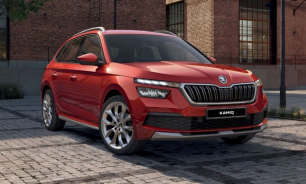Volkswagen is attempting to broaden the appeal of the Tiguan this time around. As such, it hasn’t jacked prices up massively like some recent new-generation versions of rivals, despite a comprehensive cabin tech overhaul and big lift in standard equipment.
As a result, the range is vast, with six variants covering a wide price spectrum and, as the brand says (or hopes), a wide range of potential buyers.
Kicking it off is the base model 110TSI Life, which, at $44,990 plus-road costs, is only $1000 more than the outgoing version. It sports a carryover 1.4-litre turbocharged four-cylinder engine, although it has a new version of VW’s seven-speed wet dual-clutch automatic sending power to the front wheels, replacing the derided dry dual-clutch that marred the base version of the old car.
Standard equipment on the base car is high, including 19-inch alloys, a full array of LED lights both for the headlight clusters and rears, it also includes a 12.9-inch multimedia touchscreen with wireless Apple CarPlay and Android Auto, a 10.25-inch digital instrument cluster with the brand’s signature digital cockpit software, tri-zone climate control, ‘comfort’ cloth seats (said to be benchmarked against the best in-class) with manual adjustments, a leather-trimmed multifunction steering wheel, dual wireless phone chargers, ambient dashboard lighting and even an electric tailgate.
The mid-spec Elegance grade can be chosen with either the 110TSI engine in front-wheel drive, or the new 150TSI 2.0-litre engine in all-wheel drive, priced at $50,690 and $60,690 respectively. It increases the equipment to include chrome styling on the exterior with alternate 19-inch wheel designs, rear privacy glass, improved LED headlights with a lit-up centre strip and dynamic cornering functions, leather interior trim, power adjustments with heating, ventilation, and message functions for the front two seats, and a heated steering wheel.
Alternatively, there is the 150TSI R-Line which starts at $55,690, representing a $4600 price reduction compared to the outgoing 162TSI R-Line. It is also all-wheel drive only and features an R-Line styling pack inside and outside, with sporty but manually adjusted cloth bucket seats featuring integrated headrests up front (which miss out on the heating and ventilation of the Elegance grade), black headlining, an R-line steering wheel with additional contouring, 19-inch alloys in a sportier design, a wider wheel and tyre package for enhanced grip, and the VW’s signature progressive steering tune.
Both 150TSI cars also add adaptive chassis control and hill descent control as standard, with an additional off-road and snow driving mode, while the Elegance specifically scores a larger 15-inch multimedia screen.
Finally, topping out the range is the new 195TSI R-Line priced at a massive $70,490. Not only does this grade score its own 195TSI engine sourced from the Golf GTI, but it also adds everything available in the range, swapping out the 150TSI R-Line’s cloth seats for the leather-trimmed, heated, cooled and massaging ones otherwise only available on the Elegance, along with the larger 15-inch screen, sporty steering wheel and R-Line appearance package inside and out, along with its own set of 20-inch alloy wheels.
Option packs include a black styling pack for the R-Line at $1500, a panoramic sunroof available on the Elegance and R-Line grades at $2100, and the Sound and Vision package, which adds premium audio and the larger 15-inch multimedia screen to the 110TSI variants for $2700.
This makes the Tiguan range span from surprisingly good value at the low end, to a real enthusiast-only proposition at the pinnacle, with VW even pitching the 195TSI R-Line at the lower-end BMW X3 and Mercedes-Benz GLC buyers.
In reality many of its mainstream rivals should include options like the dominant Toyota RAV4 ($42,260 - $58,360), Subaru Forester ($38,690 - $50,140), Nissan X-Trail ($38,025 - $59,265), Hyundai Tucson ($39,100 - $61,100) and Kia Sportage ($32,995 - $55,420).
The surprise, some will note, is all of the Tiguan’s rivals have at least one hybrid variant, where VW has chosen to stick with combustion only for the time being for its new-generation mid-sizer.











.png)







































.png)




















 copy.png)













